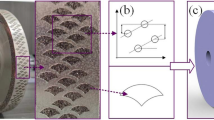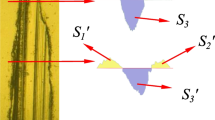Abstract
Grinding has lower green degree than other cutting methods, for which higher specific grinding energy is one of the important reasons. For reducing specific grinding energy to obtain a green process in grinding, a bionic structured surface inspired by phyllotaxis theory was developed in this paper. To verify its performance, some contrast experiments to measure specific grinding energy were conducted. The experiments of grinding surface roughness were also conducted to avoid pursuing lower specific grinding energy alone. The results showed that the bionic surface structured grinding wheel had smaller specific grinding energy with better grinding surface roughness due to the bionic pattern of grains. This research will provide a new mean for the development and application of green manufacturing technology.










Similar content being viewed by others
References
Malkin S, Guo C (2008) Grinding technology: theory and application of machining with abrasives. Industrial Press Inc.
Ding W, Zhang L, Li Z, Zhu Y, Su H, Xu J (2017) Review on grinding-induced residual stresses in metallic materials. Int J Adv Manuf Technol 88(9-12):2939–2968
Fu Y, Xu J, Ding W, Su H, Chen Y, Yang C (2016) Theory and technology of high efficiency grinding for brazed superabrasive grinding wheel. Beijing Science Press
Zhang D, Li C, Zhang Y, Jia D, Zhang X (2015) Experimental research on the energy ratio coefficient and specific grinding energy in nanoparticle jet MQL grinding. Int J Adv Manuf Technol 78(5-8):1275–1288
Zhang D, Li C, Jia D, Zhang Y, Zhang X (2015) Specific grinding energy and surface roughness of nanoparticle jet minimum quantity lubrication in grinding. Chin J Aeronaut 28(2):570–581
Jia D, Li C, Zhang Y, Yang M, Wang Y, Guo S, Cao H (2017) Specific energy and surface roughness of minimum quantity lubrication grinding Ni-based alloy with mixed vegetable oil-based nanofluids. Precis Eng 50:248–262
Zhang J, Li C, Zhang Y, Yang M, Jia D, Liu G, Hou Y, Li R, Zhang N, Wu Q, Cao H (2018) Experimental assessment of an environmentally friendly grinding process using nanofluid minimum quantity lubrication with cryogenic air. J Clean Prod 193:236–248
Guo B, Jin Q, Zhao Q, Wu M, Zeng (2016) Research progress of grinding technology with surface structured wheels. J Harb Instit Technol 48(7):1–13
Tawakoli T, Daneshi A (2013) Green grinding with innovative wheel topography. Int J Precis Eng Manuf 14(7):1209–1212
Azarhoushang B, Daneshi A (2017) Evaluation of thermal damages and residual stresses in dry grinding by structured wheels. J Clean Prod 142:1922–1930
Hwang TW, Malkin S (1999) Upper bound analysis for specific energy in grinding of ceramics. Wear 231(2):161–171
Axinte D, Butler-Smith P, Akgun C, Kolluru K (2013) On the influence of single grit micro-geometry on grinding behavior of ductile and brittle materials. Int J Mach Tools Manuf 74:12–18
Butler-Smith PW, Axinte DA, Daine M (2011) Ordered diamond micro-arrays for ultra-precision grinding—an evaluation in Ti–6Al–4V. Int J Mach Tools Manuf 51(1):54–66
Linke BS, Moreno J (2015) New concepts for bio-inspired sustainable grinding. J Manuf Process 19:73–80
Ren L, Liang Y (2016) The introduction of bionics. Science Press, Beijing
Shen F, Zhang W, Li D (2006) Origins and development of research on phyllotaxis. J North Forest Univ 34(5):83–86
Okabe T, Ishida A, Yoshimura J (2019) The unified rule of phyllotaxis explaining both spiral and non-spiral arrangements. J R Soc Interface 16(151):20180850
Lyu Y, Wang J, Zhao C, He Y (2013). An end-grinding wheel with the phyllotactic pattern of abrasive grain clusters and its mill-grinding experiments. Acta Armamentarii
Bergeron F, Reutenauer C (2019) Golden ratio and phyllotaxis, a clear mathematical link. J Math Biol 78(1-2):1–19
Yu H, Lu Y, Wang J (2016) Study on wear of the grinding wheel with an abrasive phyllotactic pattern. Wear 358:89–96
Lin B, Zhou K, Guo J, Liu QY, Wang WJ (2018) Influence of grinding parameters on surface temperature and burn behaviors of grinding rail. Tribol Int 122:151–162
Lyu Y, Yu H, Wang J, Chen C, Xiang L (2017) Study on the grinding temperature of the grinding wheel with an abrasive phyllotactic pattern. Int J Adv Manuf Technol 91(1-4):895–906
Zhu D, Xu X, Yang Z, Zhuang K, Yan S, Ding H (2018) Analysis and assessment of robotic belt grinding mechanisms by force modeling and force control experiments. Tribol Int 120:93–98
Durgumahanti UP, Singh V, Rao PV (2010) A new model for grinding force prediction and analysis. Int J Mach Tools Manuf 50(3):231–240
Wang D, Ge P, Bi W, Jiang J (2014) Grain trajectory and grain workpiece contact analyses for modeling of grinding force and energy partition. Int J Adv Manuf Technol 70(9-12):2111–2123
Funding
The authors gratefully acknowledge the support for this work from the National Natural Science Foundation of China (Grant no. 51175352), Jilin education department “13th five-year” science and technology project (Grant no. JJKH20191301KJ)
Author information
Authors and Affiliations
Corresponding author
Additional information
Publisher’s note
Springer Nature remains neutral with regard to jurisdictional claims in published maps and institutional affiliations.
Rights and permissions
About this article
Cite this article
Yu, H., Lyu, Y. & Wang, J. Green manufacturing with a bionic surface structured grinding wheel-specific energy analysis. Int J Adv Manuf Technol 104, 2999–3005 (2019). https://doi.org/10.1007/s00170-019-04159-2
Received:
Accepted:
Published:
Issue Date:
DOI: https://doi.org/10.1007/s00170-019-04159-2




